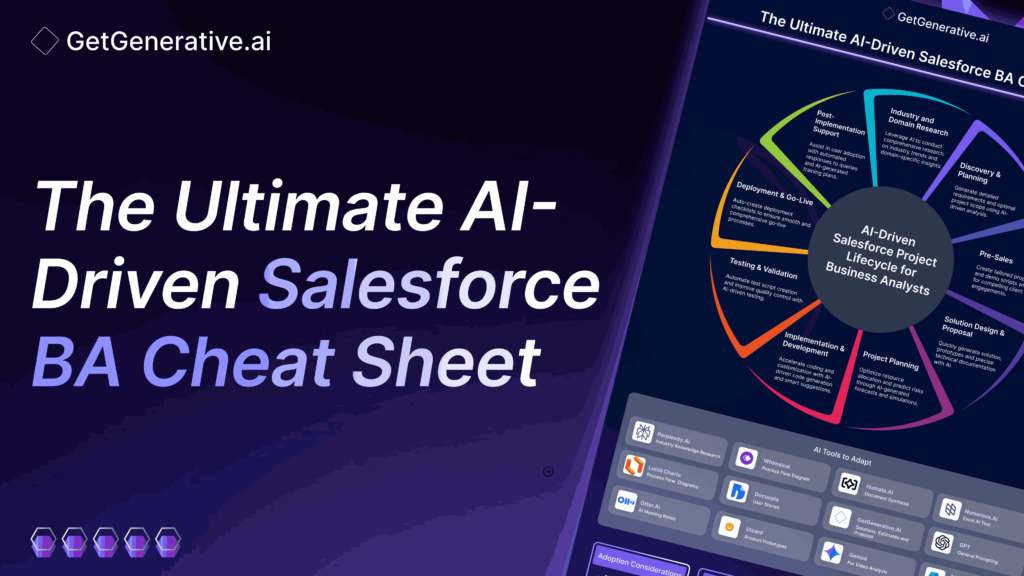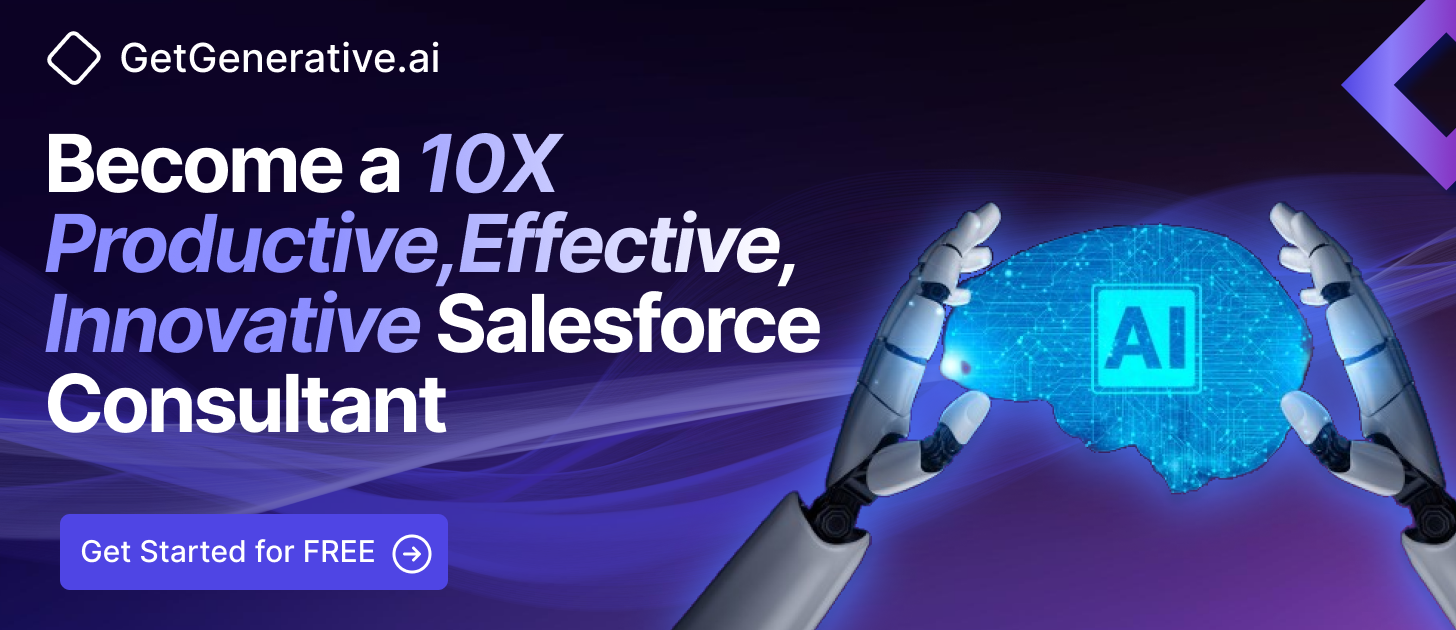The Ultimate AI-Driven Salesforce BA Cheat Sheet 2024
A recent survey by Gartner revealed that 80% of organizations have already implemented AI in some capacity, with 63% of Business Analysts reporting significant improvements in their ability to analyze data and make informed decisions source.
AI-driven solutions have emerged as powerful enablers for Salesforce BAs, streamlining processes and enhancing decision-making.
This cheat sheet will walk you through the AI-driven Salesforce project lifecycle and the essential tools and concepts you need to adapt to excel in your role.
AI-Driven Salesforce Project Life-cycle for Business Analysts
1. Industry and Domain Research
The foundation of any successful Salesforce project lies in thorough industry and domain research. By leveraging AI tools like Perplexity.AI, BAs can conduct comprehensive research on industry trends and domain-specific insights. This AI-powered tool helps you stay informed about market dynamics, ensuring that your strategies and solutions are aligned with the latest developments.
Whether you’re working in finance, healthcare, or retail, AI can quickly analyze vast amounts of data, delivering actionable insights that can shape your project’s direction.
2. Discovery & Planning
Once the research is in place, the next step is discovery and planning. AI-driven analysis enables BAs to generate detailed requirements and define an optimal project scope with precision. Tools like GetGenerative.AI come into play here, assisting in the creation of accurate solutions, estimates, and proposals.
The use of AI ensures that no detail is overlooked, and every requirement is clearly defined, reducing the likelihood of scope creep and project delays.
3. Pre-Sales
Pre-sales activities often involve creating tailored proposals and engaging client demos. With AI, this process becomes more efficient and impactful. Utilizing tools like Docuopia for user stories and GPT for general prompting, BAs can craft compelling proposals and demo scripts that resonate with potential clients. AI enhances your ability to showcase the value of your solutions, ultimately leading to higher conversion rates.
4. Solution Design & Proposal
In the solution design phase, AI helps you move swiftly from concept to prototype. AI-driven tools like Lucid Charts and Whimsical assist in creating process flow diagrams and prototypes, ensuring that your designs are not only visually appealing but also technically sound. AI’s ability to generate precise technical documentation further accelerates the proposal stage, allowing you to present a well-rounded solution to stakeholders.
5. Project Planning
Effective project planning is crucial to the success of any Salesforce implementation. AI can optimize resource allocation and predict potential risks through advanced forecasting and simulations. Numerous.AI enhances your Excel capabilities, allowing you to manipulate data, analyze trends, and automate repetitive tasks. By incorporating AI into project planning, you can create more accurate timelines and resource plans, mitigating risks before they materialize.
6. Implementation & Development
The implementation and development phase is where AI truly shines. AI’s involvement in this stage leads to a more efficient development process, reducing the time and cost associated with manual coding.
7. Testing & Validation
Quality control is a critical aspect of any project, and AI-driven testing can significantly enhance this process. By automating test script creation and employing AI-driven testing tools, BAs can ensure that the final product meets all quality standards.
8. Deployment & Go-Live
Deployment can be a stressful time, but with AI, it doesn’t have to be. Auto-creating deployment checklists through AI ensures that all necessary steps are followed, leading to a smooth and comprehensive go-live process. This automation reduces the risk of human error and allows BAs to focus on post-deployment activities, ensuring that the transition from implementation to operation is seamless.
9. Post-Implementation Support
The project doesn’t end at deployment. Post-implementation support is crucial for user adoption and system optimization. AI can assist in this phase by providing automated responses to user queries and generating AI-driven training plans.
Also Read – Salesforce Business Analyst Skill Set Cheat Sheet
Essential AI Tools for Salesforce Business Analysts
In addition to understanding the AI-driven project lifecycle, having the right tools at your disposal is crucial for maximizing efficiency and effectiveness in your role as a Salesforce BA. Below are some of the essential AI tools that can significantly enhance your productivity:
1. Perplexity.AI
- Industry Knowledge Research: Perplexity.AI is a powerful tool for conducting in-depth industry research. It enables BAs to gain insights into market trends and industry-specific data, helping you stay informed and make data-driven decisions. Whether you’re exploring new markets or deepening your knowledge in a specific domain, this tool provides the comprehensive research you need to succeed.
2. Whimsical
- Process Flow Diagrams: Whimsical simplifies the creation of process flow diagrams, allowing you to visualize business processes with ease. Its intuitive interface and AI-powered features help you create clear and effective diagrams that communicate complex processes in a straightforward manner, making it easier to collaborate with stakeholders.
3. Humata.AI
- Document Synthesis: When you need to quickly synthesize information from multiple documents, Humata.AI is your go-to tool. It extracts key insights and data from large volumes of text, saving you time and ensuring that you have all the critical information at your fingertips.
4. Numerous.AI
- Excel AI Tool: Numerous.AI takes your Excel capabilities to the next level by automating data manipulation and analysis tasks. This tool is invaluable for BAs who regularly work with large datasets and need to perform complex calculations or generate reports efficiently.
5. Lucid Charts
- Process Flow Diagrams: Lucid Charts is another excellent tool for creating detailed process flow diagrams. It’s ideal for mapping out complex business processes and ensuring that all team members have a clear understanding of how each component of the project fits together.
6. Docuopia
- User Stories: Writing user stories is an essential part of requirements gathering, and Docuopia makes this process more efficient. This AI-driven tool helps you generate clear and concise user stories, ensuring that all requirements are well-documented and understood by the development team.
7. GetGenerative.AI
- Solutions, Estimates, and Proposal: GetGenerative.AI is an indispensable tool for creating tailored solutions, accurate estimates, and compelling proposals. Its AI-driven features ensure that your outputs are precise and aligned with client needs, helping you close deals and deliver successful projects.
8. GPT
- General Prompting: GPT is a versatile tool that can assist with a wide range of tasks, from generating content to solving complex problems. Its general prompting capabilities make it a valuable asset for BAs looking to automate repetitive tasks or explore creative solutions to challenges.
9. Otter.AI
- AI Meeting Notes: Otter.AI captures and transcribes meeting notes in real-time, ensuring that you never miss a detail during discussions. This tool is particularly useful for post-implementation support, where tracking user feedback and issues is critical to the success of the project.
10. Uizard
- Product Prototypes: Uizard allows you to design and create product prototypes quickly and efficiently. This tool is perfect for early-stage product development, helping you visualize ideas and present them to stakeholders for feedback and approval.
11. Gemini
- For Video Analysis: Gemini specializes in video analysis, providing insights into visual media that can be used for training, marketing, or project validation. Whether you’re analyzing training videos or user interactions, Gemini’s AI-driven features ensure you get the most out of your video content.
12. Microsoft Copilot
- AI Presentations: Microsoft Copilot enhances your presentation capabilities by using AI to generate professional and compelling slides. Whether you’re presenting to clients, stakeholders, or your team, this tool ensures that your presentations are engaging and visually appealing.
Key Considerations for AI Adoption
Adopting AI in your Salesforce projects is not just about selecting the right tools; it’s also about understanding the broader implications and ensuring that your implementation is successful. Here are some key considerations:
- Bias and Fairness: Ensure that AI systems are designed and implemented to minimize bias and promote fairness. This includes being mindful of how AI models are trained and used, as biases in data can lead to biased outcomes.
- Transparency: Maintain transparency in how AI models operate, including how decisions are made. This builds trust with users and stakeholders, ensuring that AI-driven decisions are understood and accepted.
- Data Security: Protect the data used in AI processes, ensuring it is secure and compliant with regulations. This is particularly important in industries with strict data privacy laws, such as finance and healthcare.
- User Adoption Training: Provide comprehensive training to users for effective AI adoption. This helps ensure that your team is equipped to use AI tools effectively, maximizing the benefits of your AI investment.
- Ethical Considerations: Address ethical concerns related to AI, such as privacy and the impact on employment. This includes considering the long-term effects of AI on your workforce and ensuring that AI is used responsibly.
- Cost Implications: Consider the financial impact of implementing AI, including both initial setup costs and ongoing expenses. It’s important to weigh these costs against the expected benefits to ensure that AI adoption is financially viable.
- Data Quality: Ensure that high-quality data is used in AI models to improve accuracy and outcomes. Poor data quality can lead to inaccurate predictions and decisions, undermining the value of AI.
- Ongoing Support and Maintenance: Plan for continuous support and maintenance to keep AI systems up to date. AI technologies evolve rapidly, and regular updates are necessary to maintain performance and security.
- Vendor Reliability: Evaluate and select reliable vendors for AI solutions, ensuring long-term partnership success. A strong relationship with your AI vendor can provide ongoing support and innovation, helping you stay ahead of the curve.
Also Read – The Ultimate Salesforce Consultant Cheat Sheet
Essential Generative AI Concepts
Understanding the core concepts of Generative AI is crucial for effectively leveraging AI in your Salesforce projects. Here are some essential concepts to be familiar with:
- Prompt Engineering: Designing effective prompts to direct AI models toward accurate outputs is a key skill for any BA. This involves crafting prompts that elicit the desired responses from AI models, ensuring that the generated content meets your needs.
- Large Language Models (LLMs): LLMs are AI models that generate human-like text from vast datasets. These models are capable of understanding and producing text in a way that is often indistinguishable from human writing, making them invaluable for tasks such as content generation and customer communication.
- Machine Learning (ML): ML is the AI technique where models learn from data to make predictions. In the context of Salesforce, ML can be used to predict customer behavior, optimize marketing strategies, and more.
- Natural Language Processing (NLP): NLP enables AI to understand and generate human language. This is particularly useful in customer service and communication, where AI can be used to interact with customers in a natural and intuitive way.
- Retrieval-Augmented Generation (RAG): RAG enhances AI-generated content with information retrieval techniques. This ensures that the generated content is not only accurate but also contextually relevant and up-to-date.
- Vector Embeddings: Vector embeddings are numerical representations that help AI understand and generate contextually accurate text. This concept is fundamental to many AI applications, including search engines, recommendation systems, and more.
Conclusion
The integration of AI into the Salesforce ecosystem is transforming the role of Business Analysts. By leveraging AI tools and understanding key AI concepts, BAs can enhance their productivity, deliver more accurate and effective solutions, and drive greater value for their organizations. As you continue to navigate the ever-evolving landscape of Salesforce, keep this cheat sheet as a guide to help you stay ahead and maximize the potential of AI in your projects.
Enhance your Salesforce consulting with GetGenerative.ai. Effortlessly craft outstanding proposals, enabling you to dedicate more time to providing exceptional client service.
Start today!




